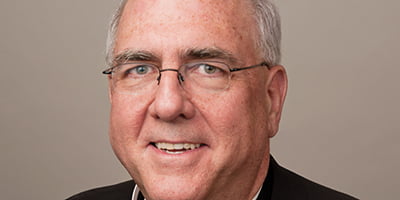by Archbishop Joseph F. Naumann
On Oct. 10, the date for publication of this column, I will be in Fatima, Portugal, on the first leg of our archdiocesan Marian pilgrimage.
The pilgrimage will also take us to Santiago de Compostela, Spain, revered as the burial site of the apostle St. James the Greater and a popular pilgrim destination since the ninth century. From Spain, we will travel to Lourdes, the most popular Marian shrine in the world. We will conclude our pilgrimage in Rome.
This archdiocesan Marian pilgrimage is part of the 25th anniversary celebration for the Catholic Foundation of Northeast Kansas. When the foundation’s leaders proposed a pilgrimage to observe its silver anniversary, I suggested that we make a Marian pilgrimage, since Mary under her title of the Immaculate Conception is the principal patron of the archdiocese.
From the very earliest times, Catholics believed that God had specially prepared Mary to be the mother of Jesus. In 1854, Pope Pius IX formally declared the dogma of Mary’s immaculate conception, which essentially acknowledged that Mary was given the gift (freedom from the effects of original sin) at her conception that we received at the time of our baptism.
Mary appeared to Bernadette at Lourdes in 1858. Initially, Mary did not reveal her identity to Bernadette. Finally, Mary identified herself as the Immaculate Conception. Bernadette was a poor, peasant girl who was not well-catechized in the faith. Bernadette had never heard of the Immaculate Conception and had no idea what the title meant.
Bernadette struggled to memorize precisely what the beautiful lady had said in order to be able to repeat it to her pastor, Father Dominique Peyramale. Father Peyramale had been preparing Bernadette for first Communion. He knew that this title was beyond Bernadette’s religious vocabulary. He became immediately convinced of the authenticity of the apparitions.
It was in this same time period — the 1850s — that the foundation for what would become the Archdiocese of Kansas City in Kansas was being laid by Bishop Jean Baptiste Miege. He had been appointed the bishop for the Vicariate Apostolic of the Indian Territory east of the Rocky Mountains. Eventually, in the 1880s, the Diocese of Leavenworth would be established, which would become, in the mid-20th century, the Archdiocese of Kansas City in Kansas.
While in Fatima, I along with our 90-plus pilgrims will consecrate ourselves to Jesus through Mary. I am urging everyone in the archdiocese to make this same Marian consecration on the solemnity of the Immaculate Conception, Dec. 8.
Integral to the consecration are 33 days of prayerful preparation. In your parishes, you should receive the opportunity to acquire, either in book or pamphlet form, “Thirty-Three Days to Morning Glory” by Father Michael Gaitley. You can also purchase this book at any of our fine Catholic bookstores. Father Gaitley provides an explanation of the history and the rationale for Marian consecration. He also gives 33 short daily meditations based on the writings and insights of St. Louis de Montfort, St. Maximilian Kolbe, Blessed Mother Teresa, and Pope St. John Paul II.
Actually, in Fatima I will be re-consecrating myself to Jesus through Mary for the third time. I will re-consecrate myself again on Dec. 8. For those who have already made a Marian consecration, I encourage you to do so again. Each time I make the consecration, I receive new insights and blessings.
One of the special graces for me this time came from one of the meditations based on Mother Teresa’s writings. Father Gaitley observes how easy it is to ignore the many blessings that surround us every day and to focus upon “daily annoyances, burdens, difficulties, and inconveniences.” I suffer from this tendency.
Despite the many hardships of her ministry and being surrounded by the misery of the sick and the dying, Mother Teresa radiated a beautiful joy. After her death, with the publication of her letters to her spiritual directors, we know that for many years, Mother Teresa experienced an incredible spiritual darkness.
Still, she was joyful. There was nothing phony about her joy. She was not putting on a happy face for others. There was no mistaking Mother Teresa’s authenticity and genuineness. How was this possible?
Father Gaitley believes it was because Mother Teresa strove to follow the example of Mary. In the second chapter of his Gospel, Luke twice tells us that Mary pondered in her heart the good things that God was doing in her life. Mother Teresa daily pondered the amazing things that God was doing in her life.
One of the tools that Mother Teresa used to ponder God’s activity in her daily life was something she borrowed from St. Ignatius Loyola, the founder of the Jesuits. St. Ignatius was a great proponent of making an examination of conscience at the end of each day.
Usually when we hear the phrase “examination of conscience,” we think about recalling our sins. While this is part of the daily examen, St. Ignatius insisted that it was essential to first ponder the blessings of the day — all the ways in which God revealed his love for us in the events and the people we encountered during the day.
It is so much better to end the day recalling God’s blessings, instead of depressing ourselves by watching the news, stewing over the problems of our own day and/or eating comfort food.
In reality, even on our worst days, God is showering us with many graces and blessings!
End your day like Mary, pondering in your heart all that God did that day in your life, and I guarantee you will sleep better and wake up happier.
Follow the example and the wisdom of Blessed Mother Teresa for several weeks and you may have people asking you for the secret for your joy.



